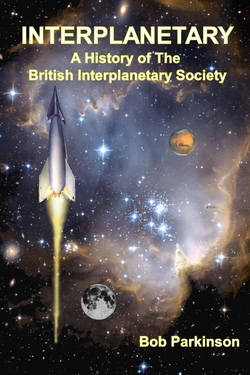Centauri Dreams
Imagining and Planning Interstellar Exploration
Robotic Networks Among the Stars
Imagine a future in which we manage to reach average speeds in the area of one percent of the speed of light. That would make for a 437-year one-way trip to the Alpha Centauri system, too long for anything manned other than generation ships or missions with crews in some kind of suspended animation. Although 0.01c is well beyond our current capabilities, there is absolutely nothing in the laws of physics that would prevent our attaining such velocities, assuming we can find the energy source to drive the vehicle. And because it seems an achievable goal, it’s worth looking at what we might do with space probes and advanced robotics that can move at such velocities.
How, in other words, would a spacefaring culture use artificial intelligence and fast probes to move beyond its parent solar system? John Mathews ( Pennyslvania State) looks at the issue in a new paper, with a nod to the work of John von Neumann on self-reproducing automata and the subsequent thoughts of Ronald Bracewell and Frank Tipler on how, even at comparatively slow (in interstellar terms) speeds like 0.01c, such a culture could spread through the galaxy. There are implications for our own future here, but also for SETI, for Mathews uses the projected human future as a model for what any civilization might accomplish. Assume the same model of incremental expansion through robotics and you may uncover the right wavelengths to use in observing an extraterrestrial civilization, if indeed one exists.
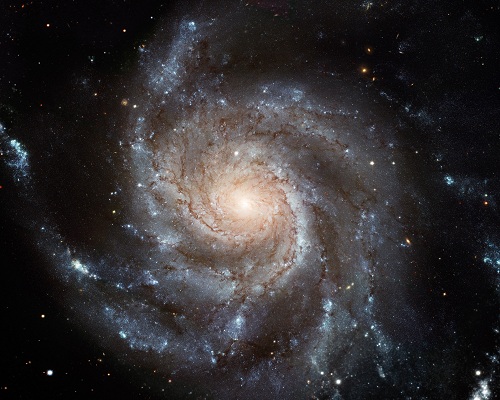
Image: The spiral galaxy M101. If civilizations choose to build them, self-reproducing robotic probes could theoretically expand across the entire disk within a scant million years, at speeds well below the speed of light. Credit: STScI.
But let’s leave SETI aside for a moment and ponder robotics and intelligent probes. Building on recent work by James and Gregory Benford on interstellar beacons, Mathews likewise wants to figure out the most efficient and cost-effective way of exploring nearby space, one that assumes exploration like this will proceed using only a small fraction of the Gross Planetary Product (GPP) and (much later) the Gross Solar System Product (GSSP). The solution, given constraints of speed and efficiency, is the autonomous, self-replicating robot, early versions of which we have already sent into the cosmos in the form of probes like our Pioneers and Voyagers.
The role of self-replicating probes — Mathews calls them Explorer roBots, or EBs — is to propagate throughout the Solar System and, eventually, the nearby galaxy, finding the resources needed to produce the next generation of automata and looking for life. Close to home, we can imagine such robotic probes moving at far less than 0.01c as they set out to do something targeted manned missions can’t accomplish, reaching and cataloging vast numbers of outer system objects. Consider that the main asteroid belt is currently known to house over 500,000 objects, while the Kuiper Belt is currently thought to have more than 70,000 100-kilometer and larger objects. Move into the Oort and we’re talking about billions of potential targets.
A wave of self-reproducing probes (with necessary constraints to avoid uninhibited growth) could range freely through these vast domains. Mathews projects forward not so many years to find that ongoing trends in computerization will allow for the gradual development of the self-sufficient robots we need, capable of using the resources they encounter on their journeys and communicating with a growing network in which observations are pooled. Thus the growth toward a truly interstellar capability is organic, moving inexorably outward through robotics of ever-increasing proficiency, a wave of exploration that does not need continual monitoring from humans who are, in any case, gradually going to be far enough away to make two-way communications less and less useful.
[Addendum: By using ‘organic’ above, I really meant to say something like ‘the growth toward a truly interstellar capability mimics an organic system…’ Sorry about the confusing use of the word!]
From the paper:
The number of objects comprising our solar system requires autonomous robotic spacecraft to visit more than just a few. As the cost of launching sufficient spacecraft from earth would quickly become prohibitive, it would seem that these spacecraft would necessarily be or become self-replicating systems. Even so, the number of robots needed to thoroughly explore the solar system on even centuries timescales is immense. These robots would form the prototype EBs (proto-EB) and would ultimately explore out to the far edge of the Oort Cloud.
The robotic network is an adjunct to manned missions within the Solar System itself, but includes the capability of data return from regions that humans would find out of reach:
These proto-EBs would also likely form a system whereby needed rare resources are mined, processed, and transported inward while also providing the basis for our outward expansion to the local galaxy. EB pioneering activities would also likely be used to establish bases for actual human habitation of the solar system should economics permit. Additionally, this outward expansion would necessarily include an efficient and cost effective, narrow-beam communications system. It is suggested that any spacefaring species would face these or very similar issues and take this or a similar path.
Note that last suggestion. It’s gigantic in its consequences, but Mathews is trying to build upon what we know — civilizations with technologies that allow them to operate outside this paradigm are an illustration of why SETI must necessarily cast a wide net. Even so, EB networks offer an area of SETI spectrum that hasn’t been well investigated, as we’ll see in tomorrow’s post.
To analyze how a robotic network like what the paper calls the Explorer Network (ENET) might be built and what it would need to move from the early proxy explorers like Voyager to later self-reproducing prototypes and then a fully functional, expansive network, Mathews explores the various systems that would be necessary and relates these to what an extraterrestrial civilization might do in a similar exploratory wave. In doing this, he reflects thinking like Frank Tipler’s, the latter having argued that colonizing the entire galactic disk using these methods would involve a matter of no more than a million years. Note that both Mathews and Tipler see the possibility of intelligence spreading throughout the galaxy with technologies that work well within the speed of light limitation. Extraterrestrial civilizations need not be hyper-advanced. “In fact,” says Mathews, “it seems possible that we have elevated ET far beyond what seems reasonable.”
This is an absorbing paper laced with ingenious ideas about how a robotic network among the stars would work, including thoughts on propulsion and deceleration, the survival of electronics in long-haul missions, and the ethics and evolution of our future robot explorers. Tomorrow I want to continue with Mathews’s concepts to address some of these questions and their implications for the Fermi paradox and SETI. For now, the paper is Mathews, “From Here to ET,” Journal of the British Interplanetary Society 64 (2011), pp. 234-241.

Oxygen Detected at Saturn’s Moon Dione
We recently looked at biosignatures as part of a discussion about using polarized light to examine exoplanet atmospheres. As if on cue, we now get a reminder of how carefully the biosignature hunt must proceed. It’s not enough, for example, to find one or two interesting gases in a distant atmosphere, for natural processes can account for potential biomarkers, which is why we need to find gases like ozone and methane, oxygen and carbon dioxide existing simultaneously. The most recent discovery from Cassini data puts an exclamation point on the matter with the discovery of molecular oxygen ions in the thin atmosphere of Dione, one of Saturn’s 62 moons.
With a radius of no more than 560 kilometers, Dione is evidently composed of a layer of water ice surrounding a rocky core. We are not, obviously, talking about a thick atmosphere around a world this small. Cassini and its CAPS instrument (Cassini Plasma Spectrometer) closed to within 503 kilometers of the surface in April of 2010, finding one oxygen ion for every 11 cubic centimeters of space in a gaseous envelope thin enough to be called an ‘exosphere.’
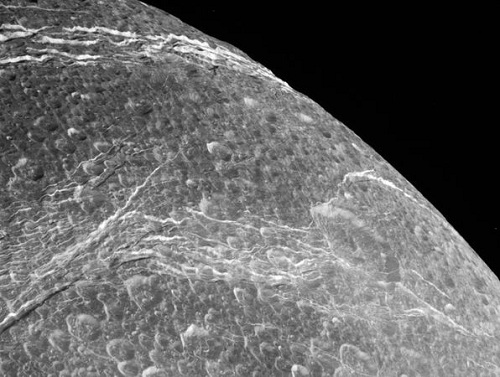
Image: The ragged surface of Saturn’s moon Dione. Credit: NASA/JPL-Caltech.
Robert Tokar (Los Alamos National Laboratory), lead author of the paper on this work, notes that the concentration of oxygen in Dione’s atmosphere is the equivalent of what we would find at an altitude of about 480 kilometers in Earth’s atmosphere. Adds Tokar:
“We now know that Dione, in addition to Saturn’s rings and the moon Rhea, is a source of oxygen molecules. This shows that molecular oxygen is actually common in the Saturn system and reinforces that it can come from a process that doesn’t involve life.”
The process is thought to work like this: During Dione’s 2.7-day orbit of Saturn, the moon is struck by charged particles produced by the planet’s inner magnetosphere, causing molecular oxygen ions to be displaced into the tenuous atmosphere, after which they are again stripped by the planet’s magnetosphere. The process of molecular oxygen displacement is called ‘sputtering,’ and while the paper notes some uncertainties in its calculations — surface temperature variations on Dione can be significant — it emphasizes the core finding:
…what is not uncertain is we report here the first in situ detection of a component of Dione’s thin sputter produced atmosphere by collecting the pick-up ions. Since the pick-up ion density is directly related to the atmospheric densities, we have also obtained a rough estimate of the atmospheric O2 density. This is consistent with the earlier observations of oxygen products trapped in the surface ice and places Dione in a category with Europa, Ganymede, Rhea and Saturn’s main rings all of which have oxygen atmospheres.
The exosphere around Rhea was detected in 2010 and is similar to Dione’s, with an oxygen density at the surface of some 5 trillion times less than what would be found at the Earth’s surface. Data from Cassini’s ion and neutral mass spectrometer from a later flyby are also under investigation. The Dione finding is not completely without interest for astrobiologists, given that molecular oxygen might be able to combine with carbon in the sub-surface lakes of gas giant moons like Europa.
The paper is Tokar et al., “Detection of exospheric O2+ at Saturn’s moon Dione,” Geophysical Research Letters Vol. 39 (2012), L03105 (abstract).

A New Take on Planet Formation
Figuring out how planets form is an old occupation, with the basic ideas of planetary accretion going back several centuries, though tuned up, to be sure, in the 1970s and tweaked ever since. In a disk of gas and dust orbiting a young central star, dust grains begin to clump together, eventually forming planetesimals. Accretion models assume that these small planetesimals bang into each other and gradually grow. The assumption is that in the inner system at least temperatures are hot and the era of planet formation occurs well after the central star has formed.
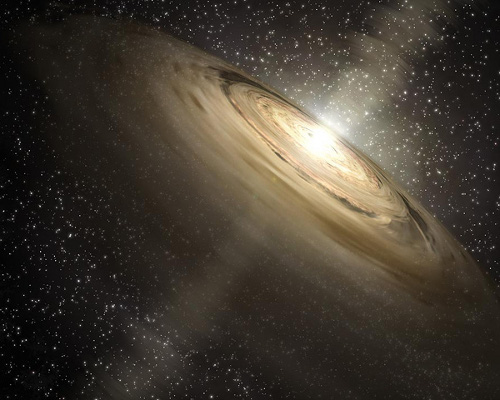
Image: Artist’s conception of a protoplanetary disk. Credit: NASA/JPL-Caltech/T. Pyle.
Adjust for distance from the star and subsequent planetary migration in the gas/dust disk and you can come up with a system more or less like ours, with rocky inner worlds and gas giants out beyond the snow line, the latter being the distance from the star where it is cool enough for volatile icy compounds to remain solid. But Anne Hofmeister and Robert Criss (Washington University, St. Louis) are presenting a new model, one in which the Sun and planets form at the same time, and at cold — not hot — temperatures. They argue that their model of a three-dimensional gas cloud explains planetary orbits better than earlier theories. Says Hofmeister:
“This model is radically different. I looked at the assumption of whether heat could be generated when the nebula contracted and found that there is too much rotational energy in the inner planets to allow energy to spill into heating the nebula. Existing models for planetary accretion assume that the planets form from the dusty 2-D disk, but they don’t conserve angular momentum. It seemed obvious to me to start with a 3-D cloud of gas, and conserve angular momentum. The key equations in the paper deal with converting gravitational potential to rotational energy, coupled with conservation of angular momentum.”
Inspiring the new theory was Hofmeister and Criss’ belief that older accretion models could not explain the fact that the planets orbit the Sun in a plane. The planet-building process would have been, after all, chaotic and haphazard, yet it leads to a Solar System demonstrating a large degree of order, with co-planar planetary orbits and axial spins that are for the most part upright. In the cold accretion model the researchers are advancing, a gravitational competition begins:
“The first thing that happens in planet accretion is forming rocky kernels,” Hofmeister says. “The nebula starts contracting, the rocky kernels form to conserve angular momentum, and that’s where the dust ends up. Once rocky kernels exist, they attract gas to them, but only if the rocky kernel is far from the Sun, can it out-compete the Sun’s gravitational pull and collect the gas, as did Jupiter and its friends. But if the rocky kernel is close, like the Earth’s, it can’t out-compete the Sun. We describe this process as gravitational competition. This is why we have the regularity, spacing, and graded composition of the Solar System.”
In other words, the model accounts for the gas giants by saying that rocky protoplanets far enough from the Sun would be able to attract nearby gas, volatiles and dust in ways the inner worlds could not. So the picture appears to be more or less like this: The slow contraction of the nebula that formed both the Sun and the planets allowed the simultaneous creation of both, with rocky protoplanets forming embedded in the dusty debris disk, which the authors believe accounts for their nearly circular co-planar orbits and upright axial spins. Those rocky planetesimals far from the accreting Sun were distant enough to form thick gaseous envelopes. As the pre-solar nebula collapsed, disk debris would have fallen toward the Sun, along the way heating whatever protoplanets it encountered as they in turn spun up as the cloud continued to shrink. The authors believe that this model, “…which allows for different behaviors of gas and dust, explains key Solar System characteristics (spin, orbits, gas giants and their compositions) and second-order features (dwarf planets, comet mineralogy, satellite system sizes).”
The paper is Hofmeister and Criss, “A Thermodynamic and Mechanical Model for Formation of the Solar System via 3-Dimensional Collapse of the Dusty Pre-Solar Nebula,” Planetary and Space Science Vol. 62, Issue 1 (March 2012), pp. 111-131 (abstract). A Washington University news release is available.

Finding Life Through Polarized Light
One of these days we’re going to have a new generation of telescopes, some in space and some on the Earth, that can analyze the atmosphere of a terrestrial world around another star. It’s not enough to find individual gases like oxygen and ozone, carbon dioxide or methane. Any of these can occur naturally without ramifications for life. But finding all of these gases in the same atmosphere is telling, because without life to replenish them, some would disappear. Getting the data is going to be hard, which is why new work using the European Southern Observatory’s Very Large Telescope is so interesting.
The work involves ‘Earthshine,’ the reflection of sunlight off the Earth that is in turn reflected off the surface of the Moon. It’s faint, to be sure, but Earthshine is visible in a crescent Moon when the light of the entire lunar disc is visible although only the crescent is brightly lit. Michael Sterzik (ESO) and team have used Earthshine to analyze our own planet’s biosignature, and the results are encouraging. The researchers could deduce from the reflection not only that part of Earth’s surface was covered with ocean, but also that vegetation was present, and both cloud cover and vegetation varied with the rotation of the Earth.
The key is to look not only at brightness variations but at how the light is polarized. This approach, called spectropolarimetry, turns out to be extremely sensitive to biosignatures in reflected light, as co-author Stefano Bagnulo (Armagh Observatory, Northern Ireland) points out:
“The light from a distant exoplanet is overwhelmed by the glare of the host star, so it’s very difficult to analyse — a bit like trying to study a grain of dust beside a powerful light bulb. But the light reflected by a planet is polarised, while the light from the host star is not. So polarimetric techniques help us to pick out the faint reflected light of an exoplanet from the dazzling starlight.”
Polarization tells us more than how bright a given object appears by revealing as well the orientation of the electric and magnetic fields that make it up. Think of the polarized light reflected off a wet road, which polarized sunglasses can reduce by suppressing part of the light (those of us with sensitive eyes rejoice in this fact). The polarized lenses pass only light whose electric vector is in a certain direction. Now we know that the direction of oscillation of the electromagnetic waves we’re studying can be a factor in exoplanet research, not only showing the presence of life but allowing us to separate a planet’s light from that of its host star.
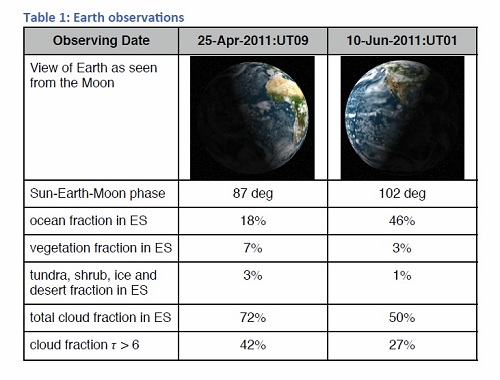
Image: A table from the paper revealing strong biosignatures through spectropolarimetry. Credit: Michael Sterzik/ESO.
The team used the FOcal Reducer/low-dispersion Spectrograph (FORS) mounted at the Very Large Telescope in Chile to measure the linear polarization spectra of Earthshine, comparing its data to models for Earth-like extrasolar planets and also to data from the space-based POLDER (POLarization and Directionality of the Earth’s Reflectances) instrument, for periods in April and June of 2011. While the results are impressive, they may be most significant in helping us tune up our tools. The paper concludes “Improved vector radiative transfer models with more realistic cloud and surface treatment are necessary to fully account for the observed spectra.”
The paper is Sterzik et al., “”Biosignatures as Revealed by Spectropolarimetry of Earthshine,” Nature 483 (01 March 2012), pp. 64-66.

Remembering an Astronautical Pioneer
by Claudio Maccone
Physicist Les Shepherd, whose funeral is today, left friends throughout the astronautical community. Claudio Maccone, who worked with Shepherd on many occasions, was quick to offer his recollections of this remarkable man whose standards of excellence and unflagging support helped many young scientists as they embarked on careers in space science.
A young guy (44 years old, i.e. “young” by IAA standards) joins the IAA Interstellar Space Exploration Committee (ISEC) headed by Les Shepherd and Giovanni Vulpetti: that happened at the World Space Congress in Washington, D.C., USA, also known as the 43rd IAC, August 28 – September 5, 1992).
I was then working at Alenia Spazio SpA in Torino (Turin), Italy, and I had this secret love for future interstellar space missions (“secret” since at my space company nobody was interested, of course). So, I consulted with my good old friend and “teacher” (he is senior than I) Giovanni Vulpetti, who was in a similar position at Telespazio in Rome as I was at Alenia Spazio in Turin (the two space companies were then “rival” in Italy, trying to get the same funds from both ESA and ASI, and sometimes from NASA also), which added “risk” to our mutual conversations. Giovanni said: “If you come to Washington D.C. at your expenses (Alenia would never have covered a mission for me to deal with interstellar exploration) then I will introduce you to Dr. Leslie Shepherd, a physicist of the highest distinction and Chair of the IAA Interstellar Exploration Committee (ISEC). At that time I had just run in Turin the first conference ever about the FOCAL space mission to 550 AU, held on June 18th, 1992, at the Politecnico di Torino (Figure 1), and so I decided to try.
I flew to Washington and met there with Les Shepherd for the first time. He was an aristocrat of physics, you know, but with a typical British sense of humor. After Giovanni introduced us to each other, at a point I felt proud enough to tell that I had done my Ph.D. at the Department of Mathematics of the University of London King’s College.
Dr. Leslie Shepherd replied “I’ll forgive you. I did my Ph.D. at University College in Gower Street!”, and of course I had to shut up, having completely forgotten the century-old rivalry between the two most renowned Colleges (so they say) on the University of London. Later I must have thought something like this: “Gee…, I just met him and immediately spoiled my reputation with this British Aristocrat of Science”. But that wasn’t the case, due to Les and Giovanni’s open-mindedness. Indeed, by the time of the 1997 IAF Congress in Torino (my town) I had already raised to the position of Secretary of ISEC, with Les Shepherd as Chair and Giovanni Vulpetti as Co-Chair. Unfortunately, ISEC was finally disbanded by the IAA in the restructuring of the IAA that took place around the year 2000, and so ISEC had to… be reinvented in other forms…
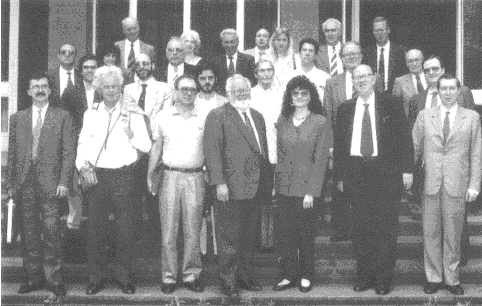
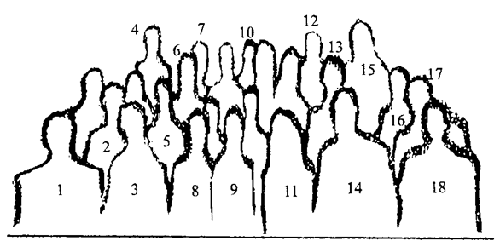
Distribution of ETCs at Various Rates of Occurrence
| Average Interval Between ETC's Appearance (Yrs) | Total Number of ETCs | Av. Distance Between ETCs (L.Y.) | No. of Stars Per ETC* *Idealized Galaxy | Av. No. of ETCs within 1000 Yrs. of our Age | Av. Dist. (L.Y.) to Nearest ETC within 1000 Yrs. of our Age |
|---|---|---|---|---|---|
| 1 billion 100 million 10 million 1 million 100,000 10,000 1000 100 10 1 | 4 40 400 4000 40,000 400,000 4 million 40 million 400 million 4 billion | 40,000 12,640 4000 1264 778 360 166 77.8 36 16.6 | 8.25 billion 825 million 82.5 million 8.25 million 825,000 82,500 8250 825 83 8 | 0.000001 0.00001 0.0001 0.001 0.01 0.1 1 10 100 1000 | ---- ---- ---- ---- ---- ---- 56,500 25,300 8000 2530 |
Figure 1: First conference ever about the FOCAL space mission to 550 AU, held on June 18th, 1992, at the Politecnico di Torino (Turin, Italy).
The relativistic rocket equation discovered by Jakob Ackeret: something Les and I had in common…
When I was a physics student in Turin (1967-72) I had to pass an exam called “Meccanica Superiore” (Higher Mechanics). That was of course classical mechanics (as opposed to quantum mechanics) and the textbook was the one on which generations of physicists have learned the subject: Classical Mechanics by Herbert Goldstein (1950). On page 213 of that book, Exercise 10, was my favorite: the relativistic rocket equation discovered by the Swiss aeronautical engineer Jakob Ackeret (1898 – 1981) and published by him in German in Helvetica Physica Acta in April 1946. Les Shepherd once told me that he also had admired that equation from the very first time he saw it, since it plainly pointed out that Einstein’s (special) relativity was not just something for particle physicists only: it could equally well be applied to relativistic interstellar flight! Actually, Les told me that he was the one who had Ackeret’s 1946 paper translated from the German into English and published in the Journal of the British Interplanetary Society, Vol. 6 (1947), pages 116-123. Thank you, Les!
Anecdote #1: how a British aristocrat could be tough enough to reject a paper he did not like
Over the years after 1992 Les, Giovanni and I also became involved in selecting the papers admitted for presentation at the ISEC Session of the IAF Congress (as the current IAC were then called) to be held on that year. I remember (it must have been at the Paris Spring Meeting in 1994) that we were uncertain about admitting or rejecting a paper for the next IAF in Jerusalem (October 9-14, 1994) (at that time my position at Alenia had somewhat improved, and so I could finally attend the IAF in Jerusalem at the company expenses: wow !). Well, I must confess that I always tried to admit papers even if I did not like them: this was due to my “prejudice” that, sometimes, young people do not have the funds to register and travel to big conferences, and they get those funds from their companies only if their paper is accepted.
So, Les and I were politely arguing about one such case, and, using the “British polite persuading techniques” that I had learned at King’s College London during my Ph.D. I thought that I could convince Les to accept that paper. Well, I was wrong. “You gave me a whole bunch of good reasons” – Les said (I still remember his words) – “why this paper must be rejected” and he was able to reverse all my arguments one by one, until the paper was finally indeed rejected. Gee… that was the generation of Defenders of the British Empire that won World War Two, you know…
Anecdote #2: how a British aristocrat could be friendly enough to “teach” Fred Astaire’s words to an Italian newcomer…
Before you go on, please click here and listen to this song. Well, this is the famous Fred Astaire – in Follow The Fleet (1936) – “We Saw The Sea” is the song. Les Shepherd was then 18 years old and so it is quite natural that he came to learn by heart all the words in the song. But it was not so natural that he could teach them many years later to an Italian newcomer learning English like myself. You see, to understand the situation better, you must remember that the Internet has not been available all that long. So, once in the late 1990’s Les and I were talking at some coffee break and I think I told Les that, in order to improve my colloquial English, I liked to watch original Anglo-American movies in TV, since the songs there could not be translated into Italian and so were the authentic songs. I added that I particularly enjoyed the above song that you just heard a little ago. Well, I had hardly finished talking when Les immediately taught me the words. He knew them all by heart, unbelievable to me! What a good Friend he was!
Anecdote #3: how a British aristocrat and his Wife could be kind enough to forgive lower-class people about their lack of culture…
Finally here is a story about Les Shepherd, his wife and my mother. Well, I am not ashamed to confess that I come from very low-class people: my father was a Pirelli worker, my mother was a dress maker, and they did not speak any foreign language. But I was their only child, they loved me, and always supported my hunger for knowledge, until I got to King’s College London for a Ph.D. in mathematics.
But let me go back to Les and his wife. Once they had to call me on the phone from England, for some reason. I was not home, I was working at Alenia, and my mother answered the phone. She heard a lady speaking English, that she could not understand at all. At a certain point, however, my mother heard this Italian word “Pastore… Pastore… Pastore”, and yet that lady on the phone kept talking English again… When I came back home after work, my mother told about that strange call, and that was a mystery for me too.
Until I met with the Shepherds several months later and Mrs. Shepherd said to me: “You know, we tried to call you on the phone… [Shepherd is Pastore in Italian], but your mother did not understand and she put the phone down.

Les Shepherd, RIP
There are so many things to say about Les Shepherd, who died on Saturday, February 18, that I scarcely know where to begin. Born in 1918, Leslie Robert Shepherd was a key player in the creation of the International Astronautical Federation (IAF), becoming its third president in 1957 — this was at the 8th Congress in Barcelona just a week after the launch of Sputnik — and in 1962 he would be called upon to serve as its president for a second time. A specialist in nuclear fission who became deeply involved in nuclear reactor technology, Shepherd was one of the founding members of the International Academy of Astronautics (IAA), and served as chairman of the Interstellar Space Exploration Committee, which met for the first time at the 1984 IAF Congress in Lausanne, Switzerland.

The IAF Congress in Stockholm the following year was the scene of the first ISEC symposium on interstellar flight, one whose papers were subsequently collected in one of the famous ‘red cover’ issues of the Journal of the British Interplanetary Society. But let’s go back a bit. Those ‘red cover’ issues might never have occurred were it not for the labors of Shepherd, who was an early member and, in 1954, the successor to Arthur C. Clarke as chairman of the organization. It was in 1952 that Shepherd’s paper “Interstellar Flight” first appeared in JBIS, a wide-ranging look at the potential for deep space journeys and their enabling technologies. He served again as BIS chairman (later president) between 1957 and 1960 and from 1965 to 1967.
I first learned about Shepherd’s career through conversations with Giancarlo Genta at the Aosta interstellar conference several years ago, a fitting place given his long association and friendship with Italian interstellar luminaries Giovanni Vulpetti, Claudio Maccone and Genta himself. It was only later that I learned that Shepherd was the organizer and first chairman of the Aosta sessions, which continue today. When I heard of Shepherd’s death, I wrote to both Vulpetti and Maccone for their thoughts, because from everything I could determine, the “Interstellar Flight” paper was one of the earliest scientific studies on how we might reach the stars. I considered it a driver for future investigations and suspected that it had a powerful influence on the next generation of scientists.
Dr. Vulpetti was able to confirm the importance of the work, which looked at nuclear fission and fusion as well as ion propulsion and went on to ponder the possibilities of antimatter. The latter is significant given how little antimatter propulsion had been studied at the time. Vulpetti goes on to say:
It may be interesting to consider the state of particle physics in which the paper of 1952 was written… For understanding some key aspects, we have to remember (a) that Dr. Shepherd was born in 1918, (b) the positron was discovered in 1932 by C. D. Anderson (USA), and (c) the antiproton was found in 1955 by E. Segré (Italy). Thus, [Shepherd] was aware of the prediction of antiproton existence made by P.A.M. Dirac in the late 1920s and 1930, but – when he wrote the paper – there existed no experimental evidence about the antiproton. Nevertheless, Dr. Shepherd realized that the matter-antimatter annihilation might have the capability to give a spaceship a high enough speed to reach nearby stars. In other words, the concept of interstellar flight (by/for human beings) may go out from pure fantasy and (slowly) come into Science, simply because the Laws of Physics would, in principle, allow it! This fundamental concept of Astronautics was accepted by investigators in the subsequent three decades, and extended/generalized just before the end of the 2nd millennium.
That the 1952 paper was ground-breaking should not minimize the contribution Shepherd made in other papers, including his 1949 and later collaborations with rocket engineer Val Cleaver on the uses of atomic energy in rocket technologies that not only examined nuclear-thermal propulsion but looked as well at the kind of nuclear-electric schemes we are now seeing actively used in operations like the Dawn mission to Vesta and Ceres. But it may be that his thoughts on antimatter in “Interstellar Flight” were his most provocative at the time — he published that paper a year before Eugen Sänger’s famous paper on photon rockets. Vulpetti adds that his work revealed the “important relationship between the mass of an annihilation-based rocket spaceship and its payload mass. This was confirmed in the 1970s, and generalized in the 1980s.”
Reading through the pages of “Interstellar Flight” is a fascinating exercise. Shepherd must confront not only the immense distances involved but the fact that at the time, we had no knowledge of any planetary systems other than our own. Yet even in this very early era of astronautics he is thinking through the implications of future technologies, and I suspect that a few science fiction stories may also have crossed his path as he pondered the likelihood of ‘generation ships’ that could take thousands of people on such journeys. From the paper:
It is obvious that a vehicle carrying a colony of men to a new system should be a veritable Noah’s Ark. Many other creatures besides man might be needed to colonize the other world. Similarly, a wide range of flora would need to be carried. A very careful control of population would be required, particularly in view of the large number of generations involved. This would apply alike to humankind and all creatures transported. Life would go on in the vehicle in a closed cycle, it would be a completely self-contained world. For this and many other obvious reasons the vehicle would assume huge proportions: it would, in fact, be a very small planetoid, weighing perhaps a million tons excluding the dead weight of propellants and fuel. Even this would be pitifully small, but clever design might make it a sufficiently varied world to make living bearable.
So wide-ranging is the “Interstellar Flight” paper that it also takes in relativistic flight (here there is no option, he believes, but antimatter for propulsion) and time dilation as experienced by the crew, and goes from there to an examination of the interstellar medium and the problems it could present to such a fast-moving vehicle. Shepherd saw early on that collisions with dust particles and interstellar gas had to be considered if a vehicle were moving at a substantial percentage of the speed of light, working out that at velocities of 200,000 kilometers per second or more, the oncoming flux would be about 1011 times as intense as that found at the top of the Earth’s atmosphere. He saw that a considerable mass of material would have to shield the living quarters of any spacecraft moving at these velocities. Project Daedalus would, in the 1970s, re-examine the problem and consider various mechanisms for shielding its unmanned probe.
Leslie Shepherd had many collaborators and, as Dr. Vulpetti told me, encouraged wide studies in propulsion systems for deep space exploration (Vulpetti himself was one of Shepherd’s collaborators — I give the citation below). I thank Giovanni Vulpetti and Claudio Maccone for their thoughts on Shepherd. Thanks also to Kelvin Long and Robert Parkinson of the BIS for helpful background information. But we’re not done: Dr. Maccone was kind enough to send along some personal recollections of Shepherd and his work that I want to run tomorrow — I had originally intended to publish them today but they give such a good sense of the man that I want to run them in their entirety as a tribute to a great figure in astronautics whose loss is deeply felt.
Les Shepherd’s ground-breaking paper on interstellar propulsion is “Interstellar Flight,” JBIS, Vol. 11, 149-167, July 1952. His 1994 paper with Giovanni Vulpetti is “Operation of Low-Thrust Nuclear-Powered Propulsion Systems from Deep Gravitational Energy Wells,” IAA-94-A.4.1.654, IAF Congress, Jerusalem, October 1994.

